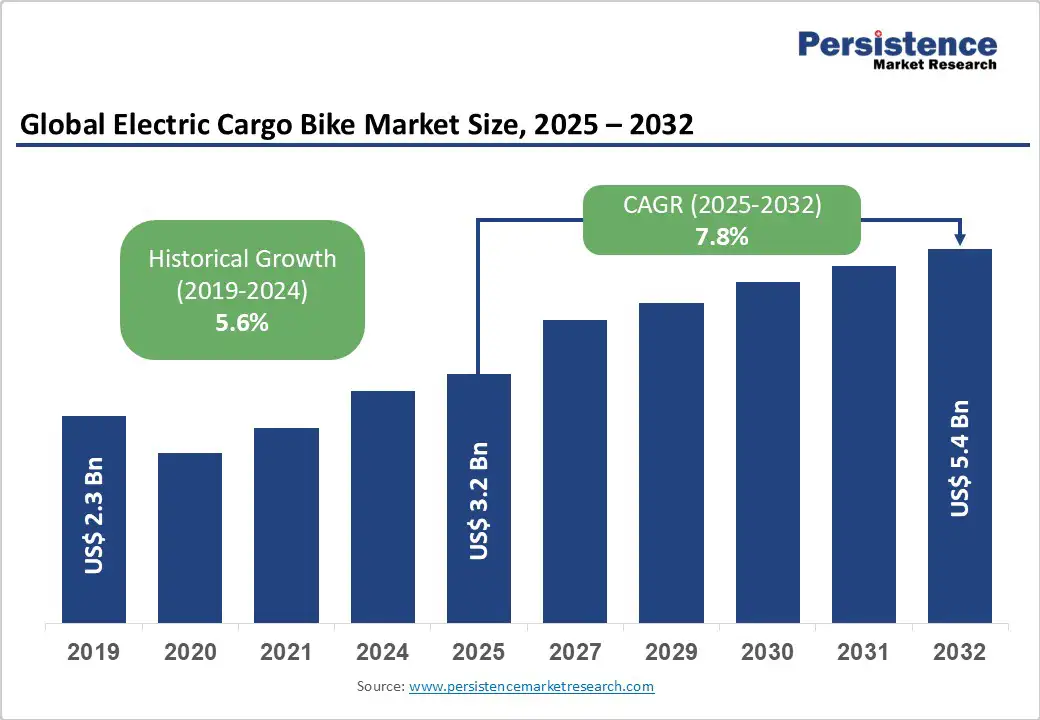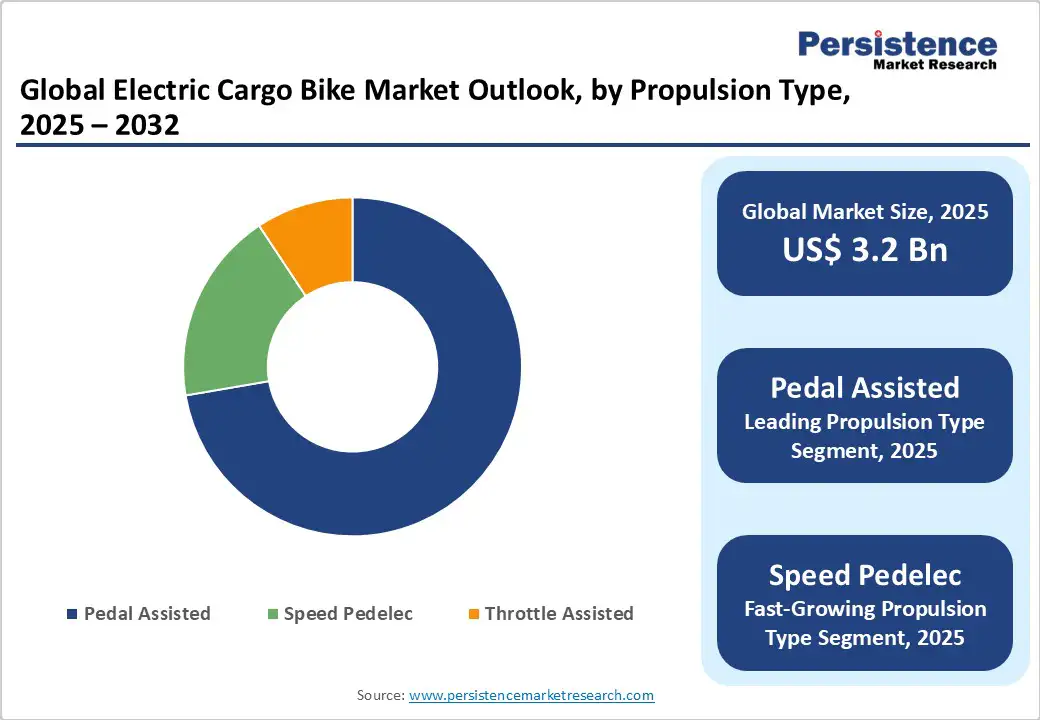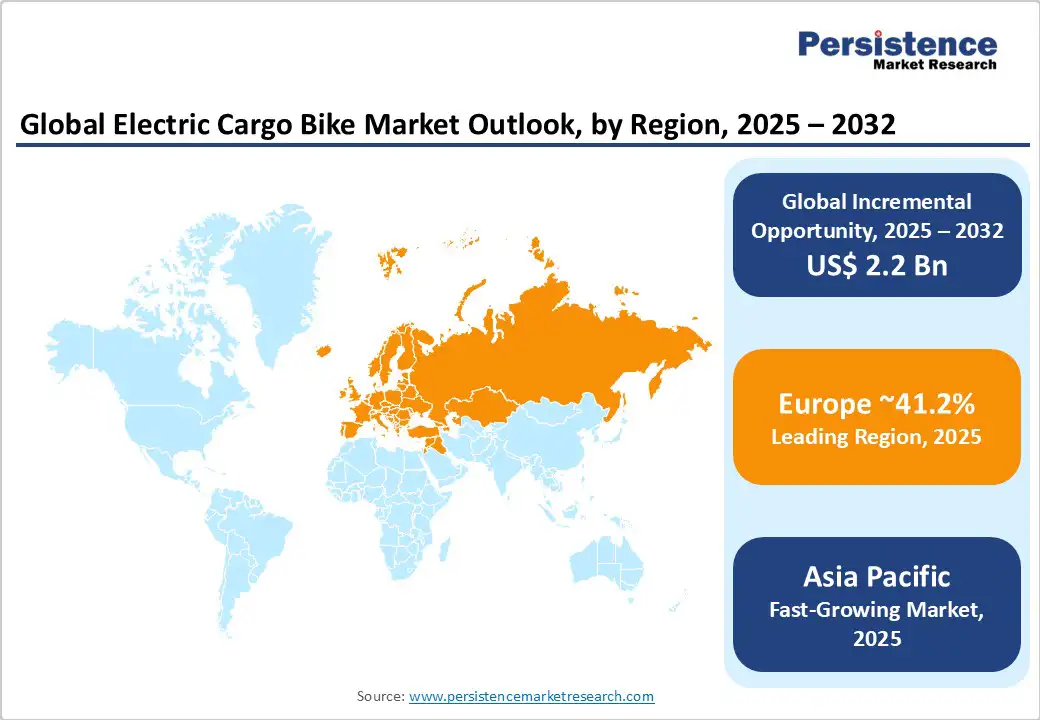ID: PMRREP25447| 150 Pages | 16 Oct 2025 | Format: PDF, Excel, PPT* | Automotive & Transportation

The global electric cargo bike market size is likely to be valued at US$3.2 Billion in 2025 and is estimated to reach US$5.4 Billion in 2032, growing at a CAGR of 7.8% during the forecast period 2025 - 2032, driven by the surging emphasis on reducing carbon emissions and promoting sustainable transportation. Governments are also providing incentives to support these eco-friendly vehicles.
| Key Insights | Details |
|---|---|
| Electric Cargo Bike Market Size (2025E) | US$3.2 Bn |
| Market Value Forecast (2032F) | US$5.4 Bn |
| Projected Growth (CAGR 2025 to 2032) | 7.8% |
| Historical Market Growth (CAGR 2019 to 2024) | 5.6% |

E-commerce growth is pushing businesses to seek fast, sustainable delivery solutions, and electric cargo bikes are filling this role. Amazon, DHL, and Alibaba have initiated pilot programs using e-cargo bikes for last-mile deliveries in dense urban centers, achieving quicker transit times while reducing emissions compared to traditional vans.
For example, DHL’s Cubicycle program in Germany integrates e-cargo bikes into city logistics, allowing delivery personnel to navigate congested streets more efficiently. This trend is fueled by consumer demand for eco-conscious shipping options and brand commitments to sustainability. Hence, the preference for green and quick delivery alternatives is becoming a leading driver for the adoption of e-cargo bikes worldwide.
The growth of electric cargo bikes is being propelled by government initiatives and municipal regulations implemented to encourage sustainable urban mobility. Various countries across Europe and Asia Pacific have introduced subsidies, tax benefits, and grants specifically for electric two-wheelers and cargo bikes. For instance, Germany provides financial incentives for businesses integrating e-cargo bikes into urban delivery fleets, while Copenhagen and Amsterdam have implemented low-emission zones favoring electric vehicles.
These measures not only reduce upfront costs for buyers but also encourage widespread adoption among commercial operators and private users, creating a conducive environment for market expansion in line with climate action and congestion reduction strategies.
One of the key challenges for electric cargo bikes is the limited range of their batteries, which can be further reduced under demanding conditions. Heavy loads, frequent stops in urban deliveries, steep inclines, and low temperatures all contribute to faster battery depletion, restricting the distance that can be covered on a single charge.
For instance, commercial fleet operators in cities across Europe have reported that e-cargo bikes carrying multiple parcels in winter require daily recharging, complicating logistics planning. This limitation affects their reliability for long routes or high-frequency deliveries, creating a need for additional charging infrastructure or backup vehicles.
Electric cargo bikes demand specialized maintenance due to their motor systems, battery management, and electronic components, which can drastically increase servicing costs. Unlike traditional bicycles, repairs often require trained technicians and specific tools, making regular upkeep expensive and less accessible in certain regions.
For example, fleet operators in North America have shown that battery replacements and motor servicing can constitute a substantial portion of operating expenses, affecting cost efficiency. Improper maintenance can further reduce battery lifespan and compromise motor performance, impacting reliability for daily logistics operations.
The explosive growth of e-commerce across global urban centers is transforming how goods are transported in cities, presenting new opportunities for electric cargo bikes. With increasing demand for quick, green, and cost-effective deliveries, e-cargo bikes are emerging as a practical alternative to traditional vans and trucks, especially for congested streets. Amazon and DHL in Europe have already piloted e-cargo bike programs in cities such as Berlin and Copenhagen, reporting improved delivery efficiency and low emissions.
This shift is further reinforced by urban policies limiting van access in central areas, creating a superior incentive for businesses to adopt e-cargo bikes. The convergence of consumer expectations for instant deliveries and city sustainability goals positions e-cargo bikes as a key solution in last-mile logistics.
Leading electric cargo bike manufacturers are now investing in state-of-the-art production facilities that integrate novel automation, robotics, and stringent quality control processes. Riese & Müller and Urban Arrow are embracing these capabilities to expand production, improve reliability, and reduce manufacturing costs while maintaining high safety standards. This approach strengthens brand reputation and also enables market expansion in regions with rising demand.
Automated production further allows manufacturers to introduce unique features such as modular cargo compartments, improved battery systems, and improved connectivity. These developments create new business opportunities by appealing to both commercial fleet operators and private consumers seeking high-performance, dependable electric cargo bikes.
The pedal-assisted segment will likely record a market share of nearly 72.3% in 2025, as it provides a balance between manual effort and electric assistance, making it practical for both commercial and personal use. Riders can rely on motor support for heavy loads or long distances, while still benefiting from physical exercise when desired. This type of propulsion is mainly suited for urban delivery scenarios where frequent stops, traffic congestion, and narrow streets demand precise control and flexibility.
Speed pedelec propulsion is gaining traction because it allows e-cargo bikes to reach high speeds, making them ideal for time-sensitive deliveries and long urban routes. Unlike standard pedal-assisted bikes, speed pedelecs can maintain fast transit without overexerting the rider, enabling businesses to improve efficiency in last-mile logistics. Urban Arrow in the Netherlands, for example, is developing speed pedelec models customized for courier services.
Lithium-ion batteries are anticipated to account for approximately 78.6% of the market share in 2025, owing to their high energy density, lightweight design, and longer lifespan compared to other battery types. They allow e-cargo bikes to carry heavy loads over long distances without frequent recharging, making them ideal for commercial deliveries and urban commuting. Also, lithium-ion technology supports quick charging and smooth integration with smart battery management systems, thereby pushing demand.
Lead-acid batteries continue to see decent demand, primarily due to their low upfront cost and superiority in simple applications. They are often used in entry-level or budget-friendly cargo bikes in emerging markets where affordability is a priority. For instance, several e-bike manufacturers in India and Southeast Asia provide lead-acid-powered cargo bikes for local deliveries and small businesses, as these batteries are durable for short, low-speed routes.
The commercial segment is poised to hold a market share of around 83.1% in 2025 as businesses increasingly rely on efficient and eco-friendly solutions for last-mile delivery. E-cargo bikes are mainly advantageous in congested urban areas, where vans and trucks face traffic delays and parking restrictions. The ability to carry significant payloads while navigating narrow streets gives businesses a competitive edge, reinforcing commercial use as the dominant segment in the market.
Personal applications of electric cargo bikes are witnessing considerable growth due to changing lifestyles, environmental awareness, and urban mobility trends. Families use e-cargo bikes to transport children, groceries, and personal goods, replacing short car trips and promoting sustainable commuting. Rising health consciousness and the desire for green alternatives also contribute to the steady uptake.

In 2025, Europe is expected to account for approximately 41.2% of the market share, as electric cargo bikes have become integral to urban mobility in the region. It is attributed to environmental policies, e-commerce growth, and a shift toward sustainable transportation.
Germany dominates the market, supported by extensive cycling infrastructure, government incentives, and a strong culture of sustainability. Berlin and Hamburg have already integrated e-cargo bikes into public transportation systems and urban logistics.
The Netherlands continues to see steady growth in terms of adoption, with a well-established cycling culture and supportive urban planning. Key cities have been at the forefront of implementing smart mobility solutions, with e-cargo bikes playing a prominent role in urban logistics.
Denmark also exhibits high adoption rates, with Copenhagen being recognized as one of the most bike-friendly cities globally. The city's infrastructure supports the widespread use of e-cargo bikes for both personal and commercial purposes.
Electric cargo bikes are gaining popularity in Asia Pacific owing to urbanization, environmental policies, and the rise of e-commerce. China leads the market with leading manufacturers such as Yadea Group and Yamaha Motor spearheading development and export growth. In India, the government is actively promoting electric mobility through initiatives such as the PM e-Drive scheme, which has been extended until March 2028.
The program delivers substantial incentives for electric vehicle purchases, including electric cargo bikes, to encourage adoption and reduce emissions. Indonesia has introduced additional incentives to promote the sale of electric vehicles, including electric cargo bikes.
These measures include the removal of the luxury tax on EVs for the 2024 fiscal year and a suspension of import tax until the end of 2025, aiming to increase domestic demand and attract investment in the automotive sector.
Electric cargo bikes are rapidly gaining momentum in North America, driven by urbanization, environmental policies, and the rise of e-commerce. In the U.S., cities, including Boston, have launched initiatives such as the country's first cargo e-bike share program, delivering a unique transportation alternative to reduce commuter stress and promote environmental benefits.
In addition, companies such as Lectric are providing affordable models, including the XPedition 2, which boasts a 120-mile range and 28 mph top speed, making it a versatile car-replacement option.
Government incentives are further accelerating adoption. For instance, Ava Community Energy in Alameda County, California, launched a US$10 Million e-bike rebate program, providing rebates ranging from US$400 to US$1,500 to residents to encourage the use of e-bikes for short trips. Several programs across Canada and the U.S. are also providing subsidies to reduce the upfront cost of electric cargo bikes.

The global electric cargo bike market consists of key players such as Rad Power Bikes, Riese & Müller, Urban Arrow, Tern Bicycles, and DOUZE Factory. They are expanding their product lines, investing in research and development, and improving their global presence to maintain a competitive edge. For instance, Lectric's XPedition 2.0 model is praised for its value, design, and performance, making it a notable option in the market.
The electric cargo bike market is projected to reach US$3.2 Billion in 2025.
Rising e-commerce demand and government incentives are the key market drivers.
The electric cargo bike market is poised to witness a CAGR of 7.8% from 2025 to 2032.
Integration of smart batteries and expanding last-mile logistics in congested cities are the key market opportunities.
Accell Group, CUBE Bikes, and Bakfiets.nl are a few key market players.
| Report Attribute | Details |
|---|---|
| Historical Data/Actuals | 2019 - 2024 |
| Forecast Period | 2025 - 2032 |
| Market Analysis | Value: US$ Bn |
| Geographical Coverage |
|
| Segmental Coverage |
|
| Competitive Analysis |
|
| Report Highlights |
|
By Propulsion Type
By Battery Type
By Application
By Region
Delivery Timelines
For more information on this report and its delivery timelines please get in touch with our sales team.
About Author